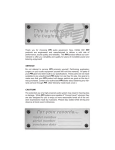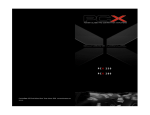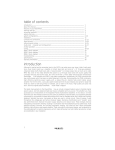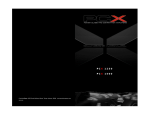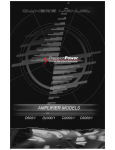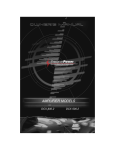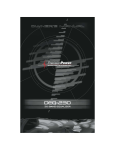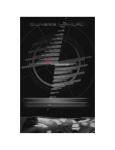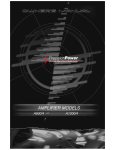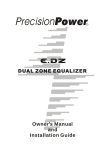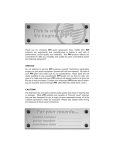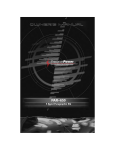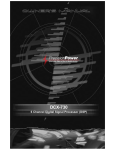Download Precision Power PC6800 User's Manual
Transcript
TM POWERCLASS PC6800 Owners Manual CONTENTS (Click on a topic to view) Congratulations Crossover Settings Features / Specifications Inputs TM QBASS PLUS Crossover Operation Installation Input, Combine, and Gain Wiring Troubleshooting Wiring (continued) Troubleshooting Power / Ground System Diagram 1 Power, Ground and Remote System Diagram 2 Speaker Wiring System Diagram 3 Bridging System Diagram 4 Endplate Diagram System Diagram 5 Controls Diagram 1 Block Diagram Controls Diagram 2 Warranty Congratulations and thank you..... for choosing PrecisionPower audio epuipment. At PrecisionPower we proudly design, engineer and manufacture audio products at our facility in Phoenix, Arizona. Our award winning engineering team utilizes innovative technology to consistently deliver Absolutely State of the Art performance, sound quality, reliability, and value. This PrecisionPower product reflects our commitment to offer you unparalleled versatility and quality for years of dependable service and listening enjoyment. TM S ervice Do not attempt to service PrecisionPower products yourself. Performing exploratory surgery on your audio equipment yourself will void the warranty. Many parts of your PrecisionPower gear are custom built to our specifications. Our factory parts are not made available to anyone else nor are they for sale. Our goal is to make sure that your PrecisionPower product will always sound as good as the day it was purchased. Contact your authorized PrecisionPower dealer about obtaining any warranty service through PrecisionPower.(See Warranty inside back cover) F O R YO U R R E C O R D S : M o d e l Serial Number Purchase Date C aution! The extended use of a high powered audio system may result in hearing loss or damage. While PrecisionPower systems are capable of "Concert Level" volumes with incredible accuracy, they are also designed for you to enjoy at more reasonable levels all of the sonic subtleties created by musicians. Please observe all local sound ordinances. BACK TO CONTENTS FEATURES / SPECIFICATIONS PWM Switching Power Supply Fully Complementary Triple Darlington Output Stage AM IV Protection Circuitry QBASS PLUS™ QBASS REMOTE™ Compatible PowerLock Speaker and Power Wire Connectors Variable, 6-Way Internal Crossover Non-Fading Sub Channels Balanced Differential Input Stage High Voltage Input Capability with Input Attenuation Switch Gold Plated RCA Input and Output Connectors Mixed Mono/Stereo Operation Multiple System Configuration PSC-221 Input Switching Three Year Warranty when installed by an Authorized PrecisionPower Dealer Completely Designed And Handcrafted In The USA Specifications Power Bandwidth: Total Harmonic Distortion: Input Topology: Input Sensitivity: Input Impedance: Load Impedance (stereo) Load Impedance (bridged) Load Impedance (bridged) Supply Voltage Damping Factor Slew Rate Idle Current: 4.5 Hz - 100 kHz 0.02 % Differential 150mv - 12 volts RMS 10k Ohms 2 - 8 Ohms 4 - 8 Ohms (Channels 1-4) 2 - 8 Ohms (Channels 5-6) 11 - 15 volts >500 >50 V/µS 2.25 Amps C o n t i nu o u s O u t p u t Pow e r CHANNELS 1/2 50 WRMS x 2 @ 4Ω per channel 100 WRMS x 2 @ 2Ω per channel 200 WRMS x 1 @ 4Ω bridged CHANNELS 3/4 50 WRMS x 2 @ 4Ω per channel 100 WRMS x 2 @ 2Ω per channel 200 WRMS x 1 @ 4Ω bridged CHANNELS 5/6 50 WRMS x 2 @ 4Ω per channel 100 WRMS x 2 @ 2Ω per channel 200 WRMS x 2 @ 1Ω per channel 200 WRMS x 1 @ 4Ω bridged 400 WRMS x 1 @ 2Ω bridged Dimensions Length - 25.25" Height - 2.25" Width - 8.9" 1 BACK TO CONTENTS QBASS PLUS ™ Q BASS PLUS ™ On POWERCLASS™ amplifiers, we've taken bass control to a higher level with QBASS PLUS™. The two QBASS switches (labeled 1 and 2) on the front end of the amplifier allow you to select one of four frequency centers - 30 Hz, 36 Hz, 44 Hz and 60 Hz. The Q SELECT switch determines the width of boosted frequencies. A 'Q' of 2 (switch out) will give you a wide boost while a 'Q' of 4 will boost a narrow range of frequencies (See chart below). On the rear end panel you will find the QBASS level control and the plug-in for an optional QBASS REMOTE™ dash mounted level control. Adjust the level control clockwise for up to 18dB of boost at your selected frequency and Q. Q BASS PLUS ™ Q B A S S ™ Settings 1 2 Freq. IN IN OUT OUT IN OUT IN OUT 30Hz 36Hz 44Hz 60Hz Q=2 Q=4 +18dB +12dB +6dB 0dB 30Hz Optional QBASS REMOTE™ This boost control can be mounted in the dash and will supersede the boost control on the endplate. 36Hz 44Hz 60Hz OT E EM QBASS R ™ d in the ndcrafte d and ha Designe USA QB AS S ™ Optional QPORT™ expansion 0 module allows one boost control to operate multiple amplifiers. Each +1 QPORT™ has outputs for four amplifiers 8 as well as another QPORT™ for greater expansion. See your Authorized PrecisionPower Dealer for more information! Crossover Specifications PC PRO 6800 Linkwitz-Riley crossover topology used throughout. High Pass (Channels 1/2, 12dB/Octave stereo) Fully Variable 20 Hz - 20 KHz. Band Pass (Channels 3/4, 12dB/Octave stereo) Fully Variable 20 Hz - 20 KHz. Sub or Band Pass Channels 5/6, (24dB/Octave mono Fully Variable 50 Hz - 500 Hz Lowpass or 12dB/Octave stereo 20 Hz - 20 KHz Bandpass). Sub or Band Pass RCA outputs will be the opposite of Channels 5/6 Crossover. QBASS PLUS™ on Lowpass assigned to Channels 5/6 or RCA OUTPUT. CAUTION: QBASS PLUS™ should only be used in systems with strong subwoofers. 18dB is a lot of bass boost and could damage full range speakers. 2 BACK TO CONTENTS INSTALLATION Tools/Parts needed for Installation (not supplied) Small flat blade screwdriver Phillips Screwdriver (#2 or medium sized) Wire cutters Wire strippers 4 - #6 round head screws, and 1 - #8 sheet metal screw (or nut, bolt, and star washer) 2 - Ring connectors (large enough to accommodate your method of grounding) In-line fuse or circuit breaker - see fuse chart below Power and ground wire - see Power Wire Calculator on page 3 Speaker wire - 16 gauge or larger Grommets (sized to work with the power wire you plan to use in your installation) Tube of silicone sealant Fuse requirements Amplifier Maximum Fuse Rating Pro6800 80 Amp You will need to install an in-line fuse or circuit breaker in the power wire within 18" of the battery. This fuse or circuit breaker is to protect your vehicle from fire in case the power wire shorts to the vehicle body. If you are only using one amplifier, use the fuse rating indicated in this chart. If you are using more than one amplifier, add up the fuse ratings for all the amplifiers. This sum is the rating for your fuse or circuit breaker. You may also want to add a power distribution block near your amplifiers to keep the wiring tidy. 3 BACK TO CONTENTS WIRING The following is a basic formula to be used as a guide to determine current draw. A 50% amplifier efficiency rating is used as an average. Your new POWERCLASS™ amplifier is more efficient, other amplifiers will probably be less. This formula is to be used as a guideline. Using wire of a larger gauge can only improve the current transfer of your system. Do not use smaller gauge wire. Total RMS output x 2 = Total Input Wattage Total Input Wattage = Current Draw (in Amps) Supply Voltage Example: A POWERCLASS™ Pro6800 amplifier has six channels at 50 watts RMS per channel into 4 Ohms (50 x 6 = 300). You would use the formula in the following way: 300W x 2 = 600W 600W = 50A Total current draw. 12V If the same amplifier is driven into a 2 Ohm stereo or 4 Ohm mono load, double it's 4 Ohm RMS rating. All POWERCLASS™ amplifiers will effectively double their power at this load. 300W x 2 x 2 = 1200W 1200W = 100A Total current draw. 12V If you are using more than one amplifier, add up the total current draw for all of them and choose the appropriate gauge based on the grand total. Pow e r W i r e C a l c u l a t o r Recommended MINIMUM Gauge Total Current Draw ( in Amps) Up to 4ft. 0-20 20-35 35-50 50-65 65-85 85-105 105-125 125-150 14 12 10 8 6 6 4 2 4 to 7ft. 12 10 8 8 6 6 4 2 Length Of Wire To Be Run 7 to 10ft. 10 to 13ft. 13 to 16ft. 16 to 19ft. 19 to 22ft. 22 to 28ft. 12 8 8 6 4 4 4 2 10 8 6 4 4 2 2 2 10 6 6 4 2 2 2 0 8 6 4 4 2 2 0 0 8 6 4 4 2 2 0 0 8 4 4 2 0 0 0 00 ( NOTE: The ground wire should be the same gauge as the power wire. 4 BACK TO CONTENTS WIRING Before beginning, disconnect the negative (-) terminal of the battery prior to working on the positive (+) terminal to prevent a short to ground. This is important, unless you want to spend the rest of your life with a nickname like "Sparky," or "Smokey." Reconnect the negative terminal only after all connections have been made. Factory Ground wire may need to be replaced if it is frayed or broken. Positive Battery Terminal Fuse must be installed within 18" of battery Run signal cables (RCAs) and remote turn-on lead down the opposite side of the vehicle of the power wire to avoid radiated noise. eject BASS LEFT 1 2 5 6 3 4 7 8 Trk 1 TREBLE BALANCE VOLUME TRACK RIGHT FOWARD PPI MAR KET ING Drill a hole in the firewall and use a rubber grommet to keep wire from shorting. DPT REVERSE Run the cables under the carpet near the side of the vehicle. Be careful not to drill or screw into the wires when you replace the trim. Avoid sharp edges that could chafe through the insulation. For systems over 300 watts, add a ground cable from the amp to the battery (see page 6). Firmly attach Amp Ground Wire to solid metal (see page 6). Wa r n i n g ! Fuse must be installed within 18" of battery 5 BACK TO CONTENTS POWER / GROUND Grounding Locate an area near the amplifier(s) that is metal and clean an area about the size of a quarter to bare metal. Inspect the area around and underneath to be sure you won't drill into wires, brake or fuel lines, etc. Drill a pilot hole in the middle of this area. Terminate the ground wire with a ring connector and attach it to the bare metal using a #8 sheet metal screw and washer or preferably, a bolt, nut and a star washer (not supplied). We suggest crimping and soldering this connection. After the connection is complete, coat the area (on both sides) with silicone or some similar material to prevent rust from developing on the bare metal. If your grand total current draw is over 50 amps (or total output power is over 300watts), you should run a ground wire beside your power wire from the battery to the amplifier(s) in addition to your regular ground wire. Keep the ground and power wires as close together as possible, and use the same gauge wire for both. This will ensure that you have a good ground path, and may eliminate such potential problems as engine noise and overheated amplifiers. Charging System Considerations If your grand total current draw is over 100 amps (or total output power is over 600watts), you are probably exceeding the capability of your charging system. Dimming lights and fluctuating voltage are solid indicators that you need to upgrade your alternator, battery (or go to multiple batteries), or both. Keep in mind that your amplifiers simply convert electrical energy to acoustical energy, and any electrical deficiency will compromise the performance of your sound system. For more information about charging system upgrades, see your local authorized PrecisionPower Dealer or call PrecisionPower technical support at: 1-800-62POWER. 6 BACK TO CONTENTS POWER / GROUND and REMOTE Once you have run both the power and ground wires, it's time to connect the cables to the amplifier. Cut off excess wire and, using wire strippers, strip the ends of the power and ground cables approximately 1/4 inch. Locate the PowerLock power and ground connector (supplied). With a small flat bladed screw driver, loosen the screws before attempting to insert the cables. Insert the wires into the appropriate hole, and tighten the screws. Once the wires are secure, the PowerLock may be plugged into the amplifier. The Power/Ground PowerLock will accommodate 4 gauge wire for the Pro6800. Power/Ground PowerLock Power wires Fastening screws Connect to Amplifier 7 BACK TO CONTENTS SPEAKER WIRING Using 16 gauge or larger, run the speaker wires from the amplifier location through the vehicle to the speakers. Observe the same precautions for routing these wires that you followed for running the power and remote turn-on wires. Cut off excess and, using wire strippers, strip 1/4 inch of insulation. Locate the speaker/remote turn-on PowerLock connector. Loosen the four outer screws on top of the connector and insert the Channels 5/6 speaker leads into the end. Check to be sure you've maintained proper polarity before securing each wire. Speaker PowerLock Connector Right Speaker negative Right Speaker positive Remote turn on Left Speaker positive Left Speaker negative Speaker PowerLock Connector Right Speaker negative Right Speaker positive Left Speaker positive Left Speaker negative Speaker/Remote PowerLock For the front and rear channels, locate the four terminal speaker PowerLock connectors. On your new Pro6800 PowerClass Amplifier, all speaker PowerLocks plug into the amplifier with the screws facing up. Loosen the screws on the top of the blocks and insert the stripped ends of the speaker wires into the end. Double check polarity, secure each wire by tightening the screws, and plug the PowerLock connector into the amplifier with the screws on top. 8 BACK TO CONTENTS BRIDGING Bridging Any or all pairs of channels (1/2, 3/4 or 5/6) on your POWERCLASS™ multi channel amplifier are capable of being bridged into a 4 ohm mono output without switches or bridging modules (2 ohm mono on Channels 5/6). This feature permits the creation of a mono channel for a subwoofer or center channel. Deriving the mono channel is accomplished by using the left channel positive wire of the pair as the positive speaker wire and the right channel negative wire as the negative speaker wire. You should always be working with the wires of a single POWERLOCK speaker connector when bridging a pair of channels. NOTE: It is important that a minimum 4 ohm impedance is observed (2 ohm mono on Channels 5/6). If the impedance drops significantly below 4 ohms while the amplifier is wired in the bridged configuration, the amplifier's protection circuitry may engage. Mixed Mono Output The ability to run stereo speakers while simultaneously running a mono output from the same channel pair is accomplished by running the stereo speakers normally and tapping into the appropriate wires for the "mixed mono" channel (left channel positive for the positive speaker wire and right channel negative for the negative speaker wire). Total speaker impedance should be no lower than 2 ohms on the stereo channels and 4 ohms on the mono channel. NOTE: Passive crossovers must be used for "mixed mono" operation. Choose a low pass crossover around 100Hz for your subwoofer, then choose a high pass crossover for your stereo channels. The high pass crossover must be at the same or slightly higher frequency than the low pass crossover to maintain the correct impedance. See your PrecisionPower dealer or call 1-800-62POWER for more information about passive crossovers. 9 BACK TO CONTENTS ENDPLATE DIAGRAM Pro6800 1. Q SELECT 4/2 Push this button in for a Q setting of 4 and out for a setting of 2. 2. QBASS 1 Use this switch with the QBASS 2 to program the QBASS PLUS™ circuit. (see page 2). 3. QBASS 2 Use this switch with the QBASS 1 to program the QBASS PLUS™ circuit. (see page 2). 4. COOLING VENTS (see page 16). 5. SPEAKER/REMOTE CONNECTOR After connecting remote and speaker wires, plug in the PowerLock connectors here (see pages 7-9). 6. -12dB For use with high level inputs (4V up to 12V). Push this switch in to attenuate the input by 12dB (see page 14). 7. INPUTS A Plug in the Front RCA leads from your head unit here (see page 14 & 16). 8. INPUTS B Plug in the Rear RCA leads from your head unit here (see page 14 & 16). 9. OUTPUTS Left and Right RCA outputs provide band pass or mono low pass signal to another amplifier. 10. POWER / MUTE indicator A green light indicates that the amplifier is on, a red light indicates that the amplifier's muting circuits have been engaged by an ACM-420. 11. QBASS™ Level Turn this control clockwise to boost the QBASS PLUS™ circuit by up to 18dB. 12. QBASS REMOTE™ plug in Plug in the data cable from the optional QBASS REMOTE™ dash mount level control here. (This will bypass the amplifier's on board QBASS™ control) 13. POWER / GROUND POWERLOCK After you have securely connected your power and ground wires, plug in the Power / Ground POWERLOCK connector here. 3 2 1 1 4 CHANNELS 1 / 2 L- L+ R+ R- 2 CHANNELS 3 / 4 L- L+ R+ R- 5 CHANNEL 5 / 6 L- L+ REM R+ R- Q SELECT 4/2 QBASS INPUTS B INPUTS A -12dB OUTPUTS RL L 7 6 RL R 8 9 4 10 PC PRO 650 12/13/96 POWER / MUTE Designed and Handcrafted in the U.S.A. QBASS 0 +18 11 + QBASS REMOTE 13 12 10 BACK TO CONTENTS 20Hz-2K X10 200Hz-20K 12dB 12dB 12dB LP / BP X10 200Hz-20K X10 200Hz-20K COMBINE switch: Switch pushed 'IN' connects the rear channels to the Inputs A. Switch 'OUT' allows front-to-rear fading. PSC: Push this switch "IN" to use a PSC-221 on channels 3/4. (COMBINE switch out) PSC 20Hz-2K X10 200Hz-20K COMBINE 20Hz-2K X10 200Hz-20K 24dB 12dB 12dB Highpass and Lowpass crossover adjustments and GAIN controls for CHANNEL 3/4 allow for either Highpass, Bandpass or Lowpass. CHANNEL 5 / 6 GAIN CHANNEL 3 / 4 GAIN When LP/BP switch is 'OUT', Bandpass crossover adjustment (Channels 5/6, 12dB/octave) is the same as Channels 3/4 and Lowpass goes to RCA OUTPUTS. OR When LP/BP switch is pressed in Channel 5/6 will be Lowpass (24dB/octave) and RCA OUTPUTS are Bandpassed. 50Hz-500Hz 20Hz-2K 20Hz-2K CHANNEL 1 / 2 GAIN Highpass crossover adjustment (12dB/octave) and GAIN control for CHANNELS 1/2 CONTROLS DIAGRAM ONE 11 BACK TO CONTENTS (RCA outputs) 70 Hz 11 20Hz-2K 21 41 IIIIIIII III I 1 Switch Pushed "IN" LP / BP X10 200Hz-20K X10 200Hz-20K 11 11 11 II II III III I 1 21 41 20Hz-2K IIII I 20Hz-2K 21 41 IIIIIIII III I 1 21 IIIIIIII Mid Range 1 41 50Hz-500Hz 32 32 32 24dB 12dB 12dB 4 KHz 20 KHz CHANNEL 5 / 6 GAIN CHANNEL 3 / 4 GAIN CHANNEL 1 / 2 GAIN Tweeters Count 9 "clicks" starting from 1 to get to 73 Hz Count 14 "clicks" starting from 1 to get to 521 Hz Count 31 "clicks" starting from 1 to get to 4 KHz Resulting frequency response at speaker outputs 521 Hz Switch Pushed "OUT" 12dB Switch Pushed "IN" 12dB Mid Bass PSC 1 41 20Hz-2K 32 32 12dB I SUB 20Hz-2K 21 41 IIIIIIII III I 32 IIIIIIII COMBINE X10 200Hz-20K 11 1 I III 20 Hz Switch Pushed "OUT" Count 16 "clicks" X10 starting from 1 200Hz-20K to get to 70 Hz Switch Pushed "IN" Count 14 "clicks" X10 starting from 1 200Hz-20K to get to 521 Hz IIIIIIII I I II Switch Pushed "IN" 21 IIIIIIII III II 11 I III I IIIIIIII III I II Count 31 "clicks" starting from 1 to get to 4 KHz II III I IIIIIIII III I IIIIIIII III I II Example Crossover Points: Tweeters / Mid - 4 KHz Mid / Midbass - 521 Hz Midbass / Sub - 70 Hz I I IIIIIIII IIIIIIII III I III I IIIIIIII I II IIIIIIII III II III I I II I IIIIIIII II IIIIIIII III I II III II II IIIIIIII Settings For A Basic 3 Way System plus Sub Output CONTROLS DIAGRAM TWO 12 BACK TO CONTENTS CROSSOVER SETTINGS All 12dB/octave 20Hz - 21KHz HighPass and BandPass Position X1-Out X10 - In 1 2 3 4 5 6 7 8 9 10 11 12 13 14 15 16 17 18 19 20 21 22 23 24 25 26 27 28 29 30 31 32 33 34 35 36 37 38 39 40 41 20 Hz 20 Hz 20 Hz 20 Hz 21 Hz 22 Hz 23 Hz 25 Hz 28 Hz 31 Hz 34 Hz 38 Hz 43 Hz 50 Hz 59 Hz 70 Hz 80 Hz 87 Hz 94 Hz 99 Hz 107 Hz 117 Hz 128 Hz 140 Hz 155 Hz 173 Hz 193 Hz 220 Hz 255 Hz 310 Hz 385 Hz 492 Hz 608 Hz 744 Hz 936 Hz 1.19 KHz 1.45 KHz 1.77 KHz 2.08 KHz 2.10 KHz 2.10 KHz 220 Hz 220 Hz 220 Hz 220 Hz 222 Hz 240 Hz 255 Hz 276 Hz 299 Hz 324 Hz 360 Hz 401 Hz 452 Hz 521 Hz 609 Hz 712 Hz 836 Hz 916 Hz 976 Hz 1.04 KHz 1.12 KHz 1.21 KHz 1.30 KHz 1.42 KHz 1.59 KHz 1.77 KHz 2.00 KHz 2.28 KHz 2.67 KHz 3.17 KHz 4.00 KHz 5.11 KHz 6.50 KHz 8.10 KHz 10.04 KHz 12.75 KHz 15.45 KHz 18.45 KHz 20.00 KHz 21.00 KHz 21.00 KHz 24dB/octave mono LowPass Position Frequency 1 2 3 4 5 6 7 8 9 10 11 12 13 14 15 16 17 18 19 20 21 22 23 24 25 26 27 28 29 30 31 32 33 34 35 36 37 38 39 40 41 52 Hz 52 Hz 54 Hz 56 Hz 56 Hz 60 Hz 64 Hz 68 Hz 73 Hz 78 Hz 85 Hz 92 Hz 102 Hz 113 Hz 127 Hz 144 Hz 158 Hz 168 Hz 175 Hz 183 Hz 191 Hz 200 Hz 210 Hz 221 Hz 234 Hz 246 Hz 260 Hz 277 Hz 295 Hz 315 Hz 337 Hz 362 Hz 382 Hz 396 Hz 410 Hz 422 Hz 431 Hz 438 Hz 444 Hz 450 Hz 450 Hz 13 BACK TO CONTENTS INPUTS There are two sets of RCA INPUTS on the front end of your amplifier. Plug the RCA cables from your head unit into the appropriate set of inputs, front and rear. If your head unit doesn't have RCA outputs don't worry. Simply add a set of RCA plugs (available at your dealer) to your front or rear set of speaker leads (see drawing below), plug them into the input jacks, and push in the -12dB switch. SOURCE Headunit eject BASS LEFT 1 2 5 6 3 4 7 8 Trk 1 TREBLE BALANCE VOLUME TRACK RIGHT FOWARD PPI MAR KET ING DPT REVERSE (+) Positive LEFT input (-) Negative (+) Positive RIGHT input (-) Negative WARNING: If you are using a source unit with bridged high powered (or "floating ground") speaker outputs, a suitable high to low level adapter must be used. If you are unsure about your head unit see your local PrecisionPower dealer or call 1-800-62Power. Balanced Differential Inputs This circuitry reduces noise radiated into your signal cables by up to 40dB. This is equivalent to a noise reduction of approximately one hundred times what the noise level would be without this circuitry. It provides all the benefits of a true 'balanced' line without the need of any special cables (see diagram below). This type of input works with any conventional RCA cable. music noise (+) ( signal and ground music noise ( ) =) noise music and noise (+) ( noise + music ( ) noise cancels =0) music NO noise 14 BACK TO CONTENTS CROSSOVER Operation Your new POWERCLASS ™ amplifier has crossover circuits built-in to provide exceptional system flexibility without the added expense and installation of an outboard crossover. CHANNELS 1/2 The first row of controls on the top of your Pro6800 allow you to send a variable highpass signal (20 Hz to 20 KHz) to Channels 1/2. (12dB/octave) With the X10 switch in the "out" position, crossover adjustment can be made by turning the highpass dial up or down for crossover points between 20 Hz and 2000 Hz. By pressing the X10 switch "in" you are able to make crossover adjustments between 200 Hz and 20 KHz. A separate gain control is designated for these channels and should be adjusted according to page 16. CHANNELS 3/4 The second row of controls on the top of your Pro6800 allow you to send a variable highpass or bandpass signal (20 Hz to 20K Hz) to Channels 3/4. These controls operate in the same fashion as above. The first set of controls are the highpass side of the bandpass, and the second set of controls are the lowpass side of the bandpass. In order to get a full highpass to 20 KHz press the second X10 switch in and turn the second (lowpass) dial fully clockwise to 20 KHz position. CHANNELS 5/6 The third row of controls on the top of your Pro6800 operate in the same fashion as Channels 3/4 crossovers. However, you have one more option on these channels: you can select a bandpass crossover (bandpass 2 - third row) or lowpass (fourth row). By leaving the LP/BP switch out the bandpass 2 signal will be assigned to CHANNEL 5/6 and lowpass assigned to the RCA outputs.By pressing the LP/BP switch in, the lowpass (fourth row) will be assigned to CHANNEL 5/6 and bandpass 2 assigned to the RCA OUTPUTS. The lowpass dial can be adjusted from 50 Hz to 500 Hz and provides a 24dB/octave slope. 15 BACK TO CONTENTS INPUT COMBINE and GAIN Input Combine Your multi channel POWERCLASS™ amplifier can use both front and rear outputs from your head unit to maintain the ability to fade front to rear, or you can run a single set of RCAs to the front inputs and push in the COMBINE switch on the amplifier end plate to route the INPUT A signal to channels 3/4 as well. PSC Switch Channels 5/6 will be used as subwoofer channels in most cases, and therefore receive summed information from Inputs A and B. This allows Front/Rear fading without affecting the subwoofer level. In order to use a PSC-221 phase shift controller on bandpassed midrange drivers (Channel 3/4) without causing cancellation in your subwoofer channels, you can isolate Inputs B to Channel 3/4 only by pushing the PSC switch 'IN'. Adjusting The Amplifier Input Gain 1. Adjust all amplifier input gain controls to just above minimum sensitivity (fully counterclockwise). 2. Using the cleanest source (CD), with music playing turn up the head unit until you can hear distortion. Now turn it down a bit until you cannot hear the distortion. 3. Increase the Amplifier gain (clockwise) until the onset of audible distortion. Then decrease the gain to the point just before the distortion starts. This setting minimizes background noise and prevents overload. 4. Repeat step 3 for any remaining amplifiers in the system. Heatsink Cooling The unique heatsink on your POWERCLASS™ amplifier has been designed with fins on the inside of the aluminum mass. This allows for the transfer of heat from the circuitry to the heatsink fins and out through the vents in the endplates. Be sure you have ample space around the amplifier for cooling, at least 2" on all sides. 16 BACK TO CONTENTS TROUBLE SHOOTING NO SOUND Is the LED lit? YES NO Check Power and Remote turnon wire for voltage. Make sure Ground wire is secure. WHAT COLOR ? GREEN RED Substitute RCA inputs with Central Muting is engaged. Remote turn-on wire must have another source, and connect a known good speaker to one more than 8 volts to release channel. central muting. Check Remote turn-on at the head unit. You may need to install a relay if the head unit doesn't put out sufficient voltage. STILL NO SOUND - See your Authorized PrecisionPower Dealer or Call 1-800-62POWER. SOUND IN ONE CHANNEL ONLY Reverse left and right speakers by unplugging the speaker connector, turning it over and plugging it back in. SOUND IS NOW IN SAME CHANNEL OPPOSITE CHANNEL Problem is in the speaker or Reverse RCA inputs speaker wire of the silent channel. SOUND IS NOW IN SAME CHANNEL OPPOSITE CHANNEL Reverse RCAs at head unit Problem is in the Amp. See your local Authorized PrecisionPower Dealer or call 1-800-62POWER. SOUND IS NOW IN SAME CHANNEL OPPOSITE CHANNEL Problem is in the head unit Problem is in the RCA cables 17 BACK TO CONTENTS TROUBLE SHOOTING NO SOUND ON BANDPASS CHANNELS Be sure that crossover points are set properly. Is the highpass set at a higher frequency than the lowpass or the lowpass set lower than the highpass, creating a no pass? NO YES Check speaker wiring for short circuits or loose connections. Be sure that powerlock plugs are in place properly (screws facing up) and observe correct wiring diagram. Readjust crossovers and then test system again. STILL NO SOUND - See your Authorized PrecisionPower Dealer or Call 1-800-62POWER. NO SOUND IN BRIDGED MODE Check speaker wiring for short circuits or loose connections. Be sure that powerlock plugs are in place properly (screws facing up) and observe correct wiring diagram. AMPLIFIER TURNS DOWN Both excessive temperature and low impedance (or short circuit) conditions will activate the amplifier's AM IV protection circuitry, which turns down the amplifier's output. When the amplifier cools down, or the impedance is corrected, the AM IV will restore full power. If your amp is turning down check your speakers and wiring for low impedance and short circuits.Also,ensure that there is nothing blocking the normal convective airflow of the amplifier. No obstruction should be within 2" of the amplifier on all sides. NOTE: Low battery voltage will cause the amplifier to run warmer. 18 BACK TO CONTENTS SYSTEM DIAGRAM ONE Source eject BASS 1 2 5 6 4 7 8 Trk 1 FOWARD Input Sensitiv ity MAR PPI TRACK RIGHT LEFT PEQ-114 3 TREBLE BALANCE VOLUME KET ING DPT REVERSE R Input L R Output L PEQ-Pre11cisionPower 4 Vol ume Powe Power + r PEQ -114 Made in USA + Sub + Low + Mid Treb le in USA 12. 8 KH z Made 16 6.4 -12db KH z KH z +12d b zer e Equali Octav 20 +12d b 10 -12db KH z -12db +12d b +12d b KH z 1.6 -12db 4 KH z +12d b +12d b Hz -12db 5 KH z +12d b -12db 800 -12db 2 KH z +12d b Hz 400 +12d b -12db +12d b 2.5 +12d b -12db KH z -12db 1 KH z +12d b Hz 200 -12db Hz +12d b +12d b -12db 1.2 7 KH z -12db 500 +12d b Hz 100 -12db Hz -12db Hz 635 -12db +12d b +12d b 126 Hz -12db 320 +12d b +12d b -12db -12db Hz De feat -12db EQ +12d b 40 -12db Hz +12d b -12db 80 -12db Hz +12d b -12db +12d b 156 +12d b -12db 31. 5 Hz Po we r Hz 25 -12db Hz +12d b DEQ-230 63 Power ision Prec Hz -12db +12d b 50 Hz -12db 250 +12d b KH z -12db 3.2 +12d b -12db 8 KH z KH z +12d b +12d b Third DEQ-230 Input stereo • mon out o • in L Outpu t R nd te Grou Remo wer Po L R IN GA /2 L1 IN GA /4 L3 NE AN CH IN GA /6 L5 NE AN CH NE AN CH B 12d K B 12d -2 Hz 20 B 24d K -2 Hz 20 0K 0 X1 z-2 0H 20 B 12d B 12d K -2 Hz 20 Hz 00 -5 Hz 50 0K 0 X1 z-2 0H 20 LP B 12d K -2 / BP Hz 20 0K 0 X1 z-2 0H 20 Pro6800 K -2 Hz 0 0K X1 z-2 0H 20 20 C PS 0K 0 X1 z-2 0H 20 CO QBA SS MB INE 1 2 L- QBA SS INP UT S A L+ R+ R- L- L+ L R+ R- L- L+ RE R M R+ R- L R L R INP UT S OU B TP UT S Channel 1 HighPass Channel 2 HighPass Channel 3 Highpass Channel 4 Highpass Channel 5/6 Lowpass Subwoofer Subwoofer Basic System Layout 19 BACK TO CONTENTS SYSTEM DIAGRAM TWO Source eject BASS 1 2 5 6 3 4 7 8 Trk 1 TREBLE BALANCE VOLUME FOWARD MAR PPI TRACK RIGHT LEFT KET ING DPT REVERSE Input L R R OutpRear ut L In pu t Se ty vi ti nsi Front Outp ut L R PAR-245 Precis PAR245ionPower Vol ume Powe r 1 2 3 4 Sub id + Fade r ct Power Low-M High-Mid R ip LED Sele Frequenc y Adju st Low F In-Cl at Treble Made in USA + Defe + Sub + Low + Low -Mid High -Mid Treb le PAR- 245 PSC-221 in USA 12. 8 KH z Made +12d b KH z 6.4 KH z -12db 16 +12d b KH z +12d b 10 220 -12db KH z -12db 600 +12d b +12d b 20 KH z -12db 3.2 -12db 8 KH z +12d b KH z 100 +12d b Po w er 600 220 -12db +12d b 100 -12db 1.2 7 KH z +12d b o +12d b -ø -12db 5 KH z KH z 2.5 +12d b -12db +12d b PS -ø -12db Hz 320 +12d b +12d b -12db -12db 156 +12d b Hz 63 -12db +12d b Pass Hz L By 80 -12db Po we r 31. 5 Hz +12d b +12d b -12db -12db Hz +12d b 40 -12db EQ ert L Inv L Pass R By Inp ut Pre ert R Inv in • outNon-inver • Inver ted ted / Acti / ByP ve ass De feat DEQ-230 Le ft Ph as e -12db Hz 635 -12db +12d b +12d b 126 Hz 25 -12db Hz +12d b DEQ-230 -12db Power ision Prec Hz -12db +12d b 50 Hz -12db Ph as e -12db +12d b -12db er onPow Precisi C-221 Rig ht 1.6 -12db 4 KH z +12d b Hz 800 -12db 2 KH z +12d b Hz 400 -12db 1 KH z +12d b Hz 200 -12db Hz 500 +12d b Hz 100 -12db Hz 250 +12d b rol Cont USA e Shift e in Phas Mad o zer e Equali Octav +12d b Third R cis r we Po ion nd te Grou Remo wer Po Input stereo • mon out o • in L Outpu t R nd te Grou Remo wer Po L R To Inputs B To Inputs A IN GA /2 L1 IN GA /4 L3 NE AN CH IN GA /6 L5 NE AN CH NE AN CH B 12d K B -2 12d Hz 20 B K -2 24d Hz Pro6800 0 0K X1 z-2 0H 20 0 0K X1 z-2 0H 20 B 12d B K 12d -2 Hz 20 LP B 12d K -2 20 Hz 00 -5 Hz 50 / BP Hz 20 0K 0 X1 z-2 0H 20 0K 0 X1 z-2 0H 20 PS 0 0K X1 z-2 0H 20 CO QBA SS K -2 Hz 20 MB C INE 1 2 L- QBA SS INP UT S A L+ R+ R- L- L+ L R+ R- L- L+ RE R M R+ R- L R L R INP UT S OU B TP UT S Channel 1 HighPass Channel 2 HighPass Channel 3 BandPass Channel 4 BandPass Channel 5/6 Lowpass Subwoofer Subwoofer System Layout Using PSC Switch 20 BACK TO CONTENTS SYSTEM DIAGRAM THREE Source eject BASS 1 2 5 6 3 4 7 8 Trk 1 TREBLE BALANCE VOLUME PPI TRACK RIGHT LEFT FOWARD R Input MAR KET ING DPT REVERSE L R OutpRear ut L t pu In ty vi ti nsi Se Front Outp ut L R PAR-245 Precis PAR245ionPower Vol ume Powe r 1 2 3 4 Sub id + Fade r ct Power Low-M High-Mid R ip LED Sele Frequenc y Adju st Low F In-Cl Defe at Treble Made in USA + + Sub + Low + Low -Mid High -Mid Treb le PAR245 IN GA /2 L1 IN GA /4 L3 NE AN CH IN GA /6 L5 NE AN CH NE AN CH B 12d K B 12d -2 Hz 20 B 24d K -2 Hz 20 0K 0 X1 z-2 0H 20 B 12d B 12d K -2 Hz 20 Hz 00 -5 Hz 50 0K 0 X1 z-2 0H 20 LP B 12d K -2 / BP Hz 0 0K X1 z-2 0H 20 20 K -2 Hz 20 0K 0 X1 z-2 0H 20 C PS 0 0K X1 z-2 0H 20 INE MB Pro6800 RCA Output Bandpass 12dB/Octave CO QBA SS 1 2 L- QBA SS INP UT S A L+ R+ R- L- L+ R+ R- L L- L+ RE R M R+ R- L R L R Channel 1 HighPass tweeter Channel 3 BandPass Midrange MidBass 4Ω SUB INP UT S OU B TP UT S PC AMP Channel 2 HighPass tweeter Channel 4 BandPass Midrange MidBass 4Ω SUB Channel 5/6 Lowpass Sub Woofers 24dB/Octave Four-Way System Layout with MidBass Amp 21 BACK TO CONTENTS SYSTEM DIAGRAM FOUR Source PSC-221 eject BASS 1 2 5 6 3 4 7 8 Trk 1 TREBLE BALANCE VOLUME FOWARD MAR PPI TRACK RIGHT LEFT KET ING DPT REVERSE 100 -ø Rig ht Po w er 600 220 o 100 -ø Cu t/ 1.5 Q Bo ost L 4 Le ft Ph as e 14K Hz -23.3 7K Hz H Q L 9.3 7K Hz -15.7 5K Hz H 4K Hz -9. 37K Hz H L +12 db 4 1.9 5K Hz -4. 5Kh z L +12 db 4 Cu t/ -12db 1.5 Bo ost Q H 940 Hz -1. 25K Hz Cu t/ -12db Bo ost 1.5 Q H L +12 db 4 Cu t/ -12db Bo ost 1.5 Q L +12 db 4 330 Hz -1KH z H 160 Hz -550H z +12 db L 4 Cu t/ -12db Bo ost 1.5 Q H 80H z-2 60H z 10 Band lizer ic Equa metr Para e in Mad Pass USA L By ert L Inv L Pass R By in • outNon-inver • Inver Inp ut ion r we Po cis Pre ert R Inv ted ted / Acti / ByP ve ass R nd te Grou Remo wer Po -12db Cu t/ -12db Bo ost 1.5 +12 db Cu t/ 4 Bo ost Po w er er Pow 10 PMQ-2 De fea t -12db EQ +12 db Cu t/ Prec -12db ision 1.5 Q +12 db L 4 Cu t/ -12db Bo ost H 1.5 Q +12 db L 4 20H z-7 0H z Bo ost H 1.5 Q +12 db L 4 Cu t/ -12db Bo ost 1.5 Q H 40H z-1 30H z Ph as e o 220 600 rol Cont USA e Shift e in Phas Mad er onPow Precisi C-221 PS To Inputs B er onPow PMQ-210 cisi Inp Pre ut attenua Outpu tion B in -12d t ster eo• mon out o•in L R R nd te Grou Remo wer Po L To Inputs A IN GA /2 L1 IN GA /4 L3 NE AN CH IN GA /6 L5 NE AN CH NE AN CH B 12d K B -2 12d Hz 20 B K -2 24d Hz 20 0K 0 X1 z-2 0H 20 B 12d B K 12d -2 Hz 20 Hz 00 -5 Hz 50 0K 0 X1 z-2 0H 20 LP B K / BP 12d -2 Hz 0K 0 X1 z-2 0H 20 20 CO QBA Pro6800 SS K -2 Hz 20 0 0K X1 z-2 0H 20 0 0K X1 z-2 0H 20 PS MB C RCA Output Lowpass 24dB/Octave INE 1 2 L- QBA SS INP UT S A L+ R+ R- L- L+ R+ R- L L- L+ RE R M R+ R- PC AMP L R L R Channel 1 HighPass tweeter Channel 3 BandPass Midrange Channel 5 BandPass MidBass 8Ω SUB INP UT S OU B TP UT S Channel 2 HighPass tweeter Channel 4 BandPass Midrange Channel 6 BandPass MidBass 8Ω SUB Four-Way System Layout using a separate PC amp for Subs 22 BACK TO CONTENTS SYSTEM DIAGRAM FIVE Source eject BASS 1 2 5 6 3 4 7 8 Trk 1 TREBLE BALANCE VOLUME FOWARD MAR PPI TRACK RIGHT LEFT KET ING DPT REVERSE R Input L In R OutpRear ut L pu t Se ty vi ti nsi R Front Outp ut L PAR-245 Precis PAR245ionPower Vol ume Powe r 1 2 3 4 Sub Low-M id High-Mid R ip + Fade r LED Sele ct Power Frequenc y Adju st Low F In-Cl + Defe at Treble Made in USA + Sub + Low + Low -Mid High -Mid Treb PAR- 245 -12db Cu t/ -12db 10 Band -12db Cu t/ lizer ic Equa metr Para e in Mad USA -12db -12db Cu t/ -12db Cu t/ Cu t/ -12db +12 db Cu t/ 4 Bo ost Po w er 1.5 Bo ost PMQ-2 De fea t -12db EQ +12 db Cu t/ -12db er Pow ision 10 Prec 1.5 Q +12 db L 4 Right -12db Bo ost H 1.5 Q +12 db L 4 20H z-7 0H z Bo ost H 1.5 Q +12 db L 4 40H z-1 30H z H Bo ost 1.5 Q +12 db L 4 Cu t/ 80H z-2 60H z H Bo ost 1.5 Q L +12 db 4 160 Hz -550H z H Bo ost 1.5 Q L +12 db 4 330 Hz -1KH z Cu t/ H Bo ost 1.5 Q L +12 db 4 940 Hz -1. 25K Hz H 1.5 Bo ost Q L +12 db 4 1.9 5K Hz -4. 5Kh z H Cu t/ 1.5 Q Bo ost L 4 4K Hz -9. 37K Hz H Q L 9.3 7K Hz -15.7 5K Hz H 14K Hz -23.3 7K Hz le PMQ-210 er onPow cisi Inp Pre ut attenua tion -12d B in L Outpu t ster eo• mon out o•in R R nd te Grou Remo wer Po L Left Y-cords Y-cords Pro6800 Pro6800 IN GA /2 L1 IN IN GA /4 L3 NE AN CH GA /2 L1 IN IN GA /4 L3 NE GA /6 L5 NE AN CH AN CH IN GA /6 L5 NE NE AN AN CH CH NE AN CH B 12d K B B 12d -2 12d Hz 20 K B 24d K -2 B 12d 20 Hz B K 12d -2 Hz 20 20 Hz 50 / BP INE K -2 Hz 20 0K 0 X1 z-2 0H 20 0K MB Hz 00 -5 0 0K X1 z-2 0H 20 LP B 12d K -2 Hz 0 0K X1 z-2 0H 20 C PS CO PS 0 0K X1 z-2 0H 20 CO SS 24d Hz 20 0K 0 X1 z-2 0H 20 B 12d / BP K -2 Hz 20 0 X1 z-2 0H 20 QBA B K -2 00 -5 Hz 50 0K 0 X1 z-2 0H 20 LP B 12d K -2 Hz 20 0 0K X1 z-2 0H 20 12d Hz Hz 20 0K 0 X1 z-2 0H 20 B 12d K -2 Hz 20 0K 0 X1 z-2 0H 20 B -2 MB C INE 1 2 QBA L- QBA SS INP UT S A L+ R+ R- SS 1 2 LL- L+ L R+ QBA R- L- L+ RE R SS INP UT S A M R+ L+ R+ R- L- L+ L R- R+ R- L- L+ RE R L M R+ R- L R R L INP R UT S OU B TP UT S L R INP UT S OU B TP UT S Left Front HighPass 200W bridged Channels 1/2 Right Front HighPass 200W bridged Channels 1/2 Left Rear HighPass 200W bridged Channels 3/4 Right Rear HighPass 200W bridged Channels 3/4 4Ω SUB 4Ω SUB 4Ω SUB 2Ω 400W bridged Channels 5/6 4Ω SUB 2Ω 400W bridged Channels 5/6 Two Pro6800 Amps bridged for Left and Right channels 23 BACK TO CONTENTS R INPUT ATTENUATION OUTPUTS L R INPUTS B L R INPUTS A L in out in out Dif. Dif. Dif. Dif. in Crossover Select Switch out in out in out in in out out PLUS™ QBASS PSC SWITCH in QBASS REMOTE™ 50Hz - 500Hz 24 dB/octave Low Pass out input combine 20Hz - 2KHz x10 200Hz - 20KHz 12 dB/octave High Pass 20Hz - 2KHz x10 200Hz - 20KHz 12 dB/octave High Pass 20Hz - 2KHz x10 200Hz - 20KHz 12 dB/octave High Pass 20Hz - 2KHz x10 200Hz - 20KHz 12 dB/octave High Pass 20Hz - 2KHz x10 200Hz - 20KHz 12 dB/octave High Pass 20Hz - 2KHz x10 200Hz - 20KHz 12 dB/octave High Pass Inverter 20Hz - 2KHz x10 200Hz - 20KHz 12 dB/octave Low Pass 20Hz - 2KHz x10 200Hz - 20KHz 12 dB/octave Low Pass 20Hz - 2KHz x10 200Hz - 20KHz 12 dB/octave Low Pass 20Hz - 2KHz x10 200Hz - 20KHz 12 dB/octave Low Pass Inverter Inverter Gain Adjust Gain Adjust Gain Adjust mute mute mute mute mute mute AMP CHANNEL 5/6 AMP AMP CHANNEL 3/4 AMP AMP CHANNEL 1/2 AMP BLOCK DIAGRAM Pro6800 MUTE 24 BACK TO CONTENTS WA R R A N T Y Three-Year Limited U.S.A. Warranty This warranty gives you specific legal rights, and you may also have other rights which vary from state to state. PrecisionPower warrants its products to be free from defects in materials and workmanship under normal use and service for a period of three (3) years from the date of original purchase when the unit is installed by an Authorized Dealer. Non-Authorized Dealer installed products carry a one (1) year parts and ninety (90) days labor limited warranty. The extent and conditions of Limited Warranty are as follows: 1. Authorized Dealer Installed Products: PrecisionPower will either repair or replace at no charge, to the original purchaser, any unit which PrecisionPower’s examination discloses to be defective and under warranty, provided the defect occurs within three (3) years from the date of original purchase when the unit is installed by an Authorized Dealer and the product is returned immediately to PrecisionPower. This warranty is not transferable. 2. Non-Authorized Dealer Installed Products: PrecisionPower will either repair or replace at no charge, to the original purchaser, any unit which PrecisionPower’s examination discloses to be defective and under warranty, provided the defect occurs within ninety (90) days from the date of purchase and the product is returned immediately to PrecisionPower. Warranty claims beyond ninety (90) days for Non-Authorized Dealer Installed Products will be for parts only and will extend for one (1) year from the date of purchase. This warranty is not transferable. 3. The date of purchase and proof of Authorized Dealer Installation of a PrecisionPower product must be established by an original sales receipt which must accompany the article being returned for warranty work. 4. This warranty shall NOT apply to any PrecisionPower product found to have the original factory serial number removed or defaced. All products received (by PrecisionPower) for in warranty or out of warranty repair, with their original serial numbers removed or defaced, will NOT be repaired and will be returned to sender, freight collect. Refer to original packaging for the serial number of your component speakers. 5. The provisions of this warranty shall not apply to any PrecisionPower product used for a purpose for which it is not designed, which has been repaired or altered in any way, or which has been connected, installed, or adjusted other than in accordance with the instructions furnished in PrecisionPower’s owner’s manual. Nor shall this warranty apply to any part which has been subject to misuse, neglect, or accident. 6. PrecisionPower does not authorize any other persons to assume any other liability in connection with its products. THIS WARRANTY IS THE ONLY EXPRESS WARRANTY MADE BY PRECISIONPOWER APPLICABLE TO ITS PRODUCTS. ANY IMPLIED WARRANTY OR MERCHANTABILITY OR FITNESS FOR A PARTICULAR PURPOSE APPLICABLE TO PRECISIONPOWER PRODUCTS IS LIMITED IN DURATION TO THE DURATION OF THIS LIMITED WARRANTY. PRECISIONPOWER SHALL NOT BE LIABLE FOR THE INCIDENTAL, CONSEQUENTIAL, OR COMMERCIAL DAMAGES RESULTING FROM THE BREACH OF THIS WRITTEN WARRANTY. Some states or provinces do not allow the exclusion or limitation of incidental or consequential damages or limitations on how long an implied warranty lasts; so the above limitations or exclusions may not apply to you. 7. Your product will be serviced on an in-warranty basis within the warranty period for the correction of warranted defects. If improper operation of your PrecisionPower product should occur, contact your Authorized Dealer for assistance with the return and factory repair of your PrecisionPower product. If an Authorized Dealer is not available, return the unit including your name, telephone number, return address, a copy of your sales receipt, and a description of the problem to: PrecisionPower,Inc. Service Department 4829 S. 38th Street Phoenix, AZ 85040-2964 TO RETURN PRECISIONPOWER PRODUCTS OUT OF WARRANTY: Return the unit, postage prepaid, in the original protective carton. Please include a description of the problem and, if desired, a request for an estimate of repair costs. Unless a request for an estimate is included, the unit will be repaired as necessary. Please contact PrecisionPower Customer Service at 1800-62-POWER for questions concerning out of warranty repair charges. Repaired unit will be returned with an itemized statement, C.O.D. BACK TO CONTENTS





























